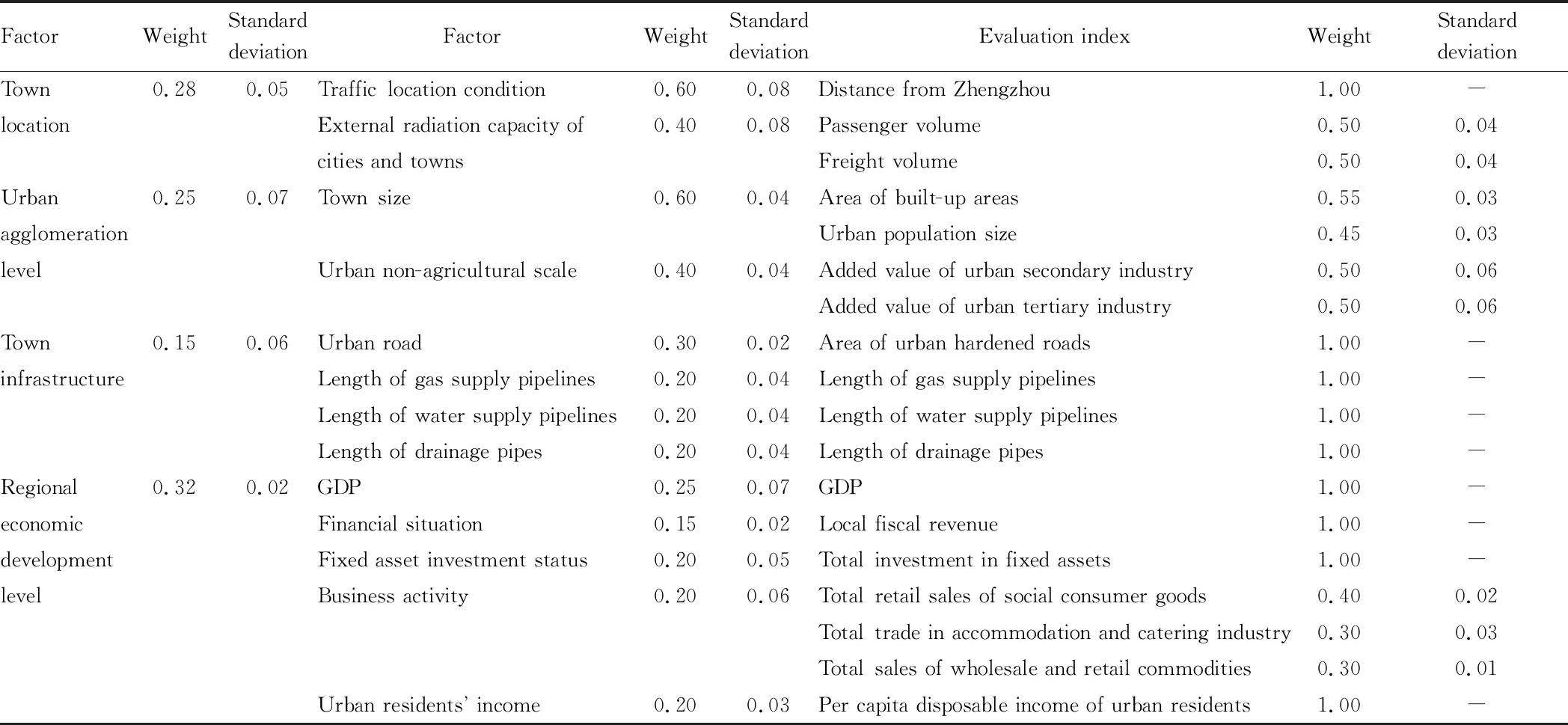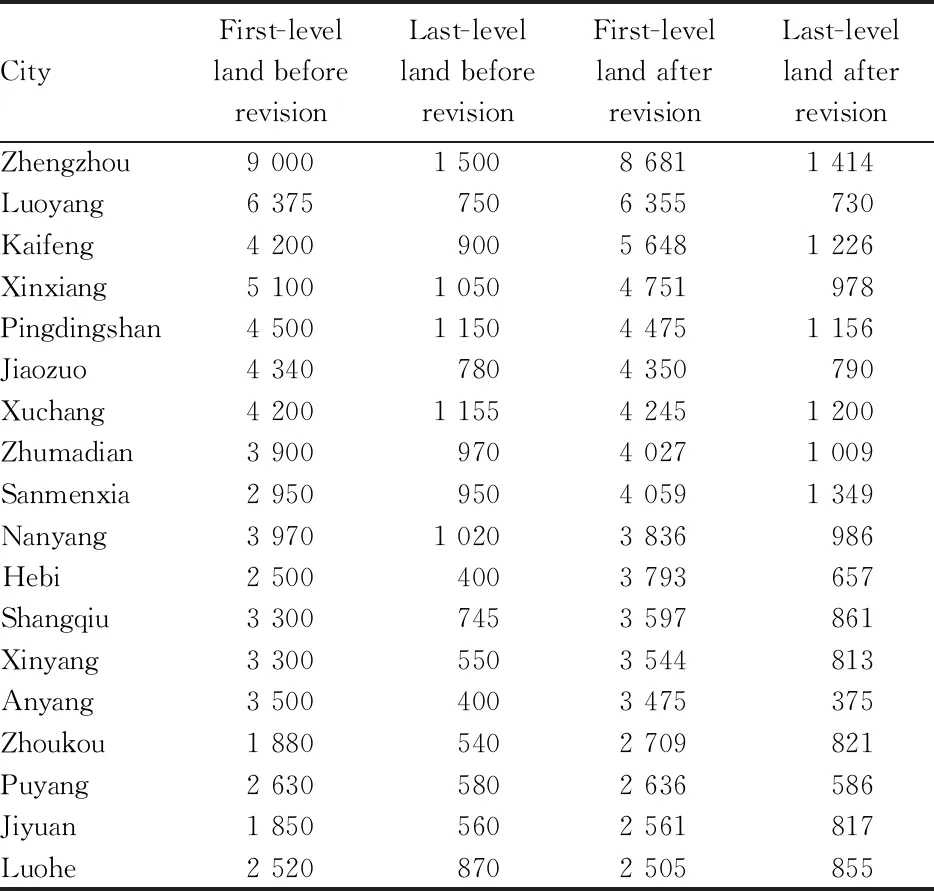Research on the Balance of Urban Benchmark Land Price in Henan Province: A Case Study of Commercial Land
2021-12-31YanTIANLishengSONGZiweiWANGLeiWANGXihuiYANGQingweiYANG
Yan TIAN, Lisheng SONG, Ziwei WANG*, Lei WANG, Xihui YANG, Qingwei YANG
1. Institute of Geography, Henan Academy of Sciences, Zhengzhou 450052, China; 2. Henan Kefa Geographic Research Institute Co., Ltd., Zhengzhou 450052, China
Abstract The balance of benchmark land price is an important part of the work of urban benchmark land price. By constructing different levels of factor layers, the balance of benchmark land price of urban commercial land in the urban areas of 18 provincial cities in Henan Province was studied. The urban areas were divided into 5 classes. It is found that the land price level in each urban area is basically consistent with the level of economic development, and the land price in some urban areas is low under the influnece of local policy.
Key words Benchmark land price, Balance, Commercial land, Henan Province
1 Overview of the study area
Henan (31°23′-36°22′ N, 110°21′-116°39′ E) is located in the middle-eastern part of China and the middle and lower reaches of the Yellow River. It is connected to Anhui and Shandong in the east, Hebei and Shanxi in the north, Shaanxi in the west and Hubei in the south. The terrain is high in the west and low in the east, straddling the four major water systems of the Haihe River, the Yellow River, the Huaihe River and the Yangtze River. It has a warm temperate-subtropical, humid-semi-humid monsoon climate. At the end of 2013, the total population was 106.01 million, and the total land area of the province was 167 000 km. The balance objects are the coordination and convergence of commercial land price within the main urban areas of 17 provincial cities under the jurisdiction of Henan Province (such as Zhengzhou, Kaifeng, Luoyang, Pingdingshan, Anyang, Hebi, Xinxiang, Jiaozuo, Puyang, Xuchang, Luohe, Sanmenxia, Nanyang, Shangqiu, Xinyang, Zhoukou, and Zhumadian) and Jiyuan City.
2 Balancing technical route
(i) According to the requirements of theUrban
Land
Classification
and
Grading
Regulations
, the urban land quality of each urban area shall be ranked and sorted, and the grading index shall be used as the basic control basis to determine the comparison order of each urban area.(ii) According to the actual situation of Henan Province, the land price level of each urban area shall be uniformly set and revised accordingly. Meanwhile, the land price expression form shall be unified.
(iii)According to the economic and social indicators that affect the quality of urban land, each urban area is ranked. The index value of each urban area is obtained based on the weight of the indicators.
(iv)According to the above-mentioned grading index and the revised minimum and maximum land price levels in each urban area, the corresponding interval of the grade index and land price value is divided, and the price levels of each urban area are sorted according to the grade index.
(v)According to the characteristics of different land types, corresponding indicators are selected to revise the control value of city-level balanced land price based on the balance index and then obtain the preliminary results after land price is balanced.
(vi)The results are sent to each urban area. The municipal bureau of land and resources will organize relevant experts to conduct demonstrations, and the provincial department of land and resources will organize relevant experts to demonstrate the preliminary balance results of urban benchmark land price in various urban areas.
(vii)Based on the opinions of provincial and municipal experts and the actual price level of each urban area, the final balance result of urban benchmark land price in each urban area is determined.
3 Benchmark land price balance
In order to balance the benchmark land price level of various towns, the connotation of benchmark land price is set as follows: it is the average price of land use right of the same land use type among various types of construction land in towns at a certain degree of development, a certain land plot ratio, a maximum transfer period on a certain valuation benchmark day.
3.1 Degree of land development
According to the current status of urban areas and land use classification, the development level is set to seven connections and one leveling, with road connection, electricity connection, communication, upper water connection, lower water connection, gas connection, heating and land leveling.3.2 Land plot ratio
The plot ratio of commercial land, residential land, industrial and mining storage land, transportation land, water conservancy facility land, special land, and public management and public service land is 2.5, 2.5, 1.0, 1.0, 1.0, 1.0, and 1.5 respectively.3.3 Land transfer period
The transfer period of commercial land, residential land, industrial and mining storage land, transportation land, water conservancy facility land, special land, public management and public service land (excluding tourism and entertainment land), and public management and public service land (including tourism and entertainment land) is 40, 70, 50, 50, 50, 50, 50 and 40 years.3.4 Benchmark date of valuation
The updated benchmark date of valuation for this benchmark land price is January 1, 2013.4 Calculation of balance index
4.1 Principles for the selection of balance factors
(i) The change in the balance factors of urban benchmark land price has a significant impact on the quality of urban land, and can directly and objectively reflect the level of urban land in the evaluated area; (ii) the balance factors of urban benchmark land price varied greatly; (iii) the selected factors have large differences in the impact on different types of cities and towns, and their indicators can reflect the differences in land among different types of cities and towns; (iv) the balance factors of urban benchmark land price reflect the current development trend of land use, and have an impact on the future land of cities and towns; (v) the balance factors of urban benchmark land price are easy to obtain through statistical data or easy to quantify.4.2 Balance indicator system and weight
4.2.1
Principles for the selection of balance indicators of land price. (i) The change in the balance factors of land price has a significant impact on the benchmark land price, and can directly and objectively reflect the benchmark land price and land quality in the balanced area; (ii) the balance factors of land price change in a large range; (iii) the selected factors have great differences in the impact on different regions, and can reflect the difference in benchmark land price between various regions; (iv) the balance factors of land price reflect the current land use status, and will affect future land use; (v) the balance factors of land price are easy to obtain through statistical data or easy to quantify.4.2.2
Index system construction and weight determination. According to the above principles, as well as the actual situation of the province, 25 experts from the departments of land, planning, statistics, industry and commerce, transportation,etc.
were invited to select the balance factors at various levels using the classic Delphi method, and the weight of balance factors for each category was determined after two rounds of consultation and scoring. The grading scopes of benchmark land price in the 18 cities are quite different, and the last-level land between urban areas differs greatly in respects of geomorphology, scale, and transportation, so there is a separate index system for the final land. The balance indicators of benchmark land price and their weights for the first-level land - secondary last-level land in Henan Province are shown in Table 1, and the balance indicators of benchmark land price and their weights for the final land is shown in Table 2.
Table 1 Balance indicators and weights of the first-level land-secondary last-level land in each urban commercial area

Table 2 Balance indicators of benchmark land price and their weights for the last-level land in each urban area
According to the results of the balance index, the cities are ranked as follows: the first-class city is Zhengzhou; the second-class cities are Luoyang, Xinxiang, and Kaifeng; the third-class cities include Xuchang, Luohe, Jiaozuo, Pingdingshan, Anyang cities; the fourth-class cities are Hebi City, Jiyuan City, Nanyang City, Puyang City, and Shangqiu City; the fifth-class cities include Zhumadian City, Zhoukou City, Xinyang City, and Sanmenxia City.
4.3 Revised price after the unification of benchmark land price connotation
The revised price before and after the unification of benchmark land price connotation is shown in Table 3.
Table 3 Revised benchmark land price of commercial land in 2013
5 Analysis of balance results
5.1 Relationship between urban land price results and urban level
In general, the higher the urban level is, the higher the benchmark land price of the same land type at the same level is. For a certain town, since commercial land generally occupies a relatively prosperous area, its benchmark land price is generally higher than the benchmark land price of residential land and industrial and mining storage land, while that of residential land is generally higher than that of industrial and mining storage land. The balance results of urban benchmark land price in each city of Henan Province also conform to this law. In addition, with the decline in the grade of cities, the land price of various types of land at the same level has shown a downward trend. The industries and social groups in the urban system are interdependent and complementary, so that when the population and industries are gathered to a certain degree in the cities and towns, large-scale production and management can be formed, and agglomeration benefits can be generated.Among the 18 cities as a whole, the first-class cities have the most land classes, followed by the second-class cities, and the last-class cities have the least classes. Generally speaking, the higher the level of a city is, the higher its level of development is, the larger the built-up area is; the larger the city area is, the more significant the regional difference is, the greater the difference in land price is, and the greater the level of division is. However, sometimes according to actual needs, more land levels may be divided in lower-level cities.
5.2 Distribution characteristics of urban commercial land price in Henan Province
5.2.1
The land price level is basically consistent with the economic level. Based on the analysis of benchmark land price in the 18 cities under the jurisdiction of Henan Province, they are divided into 3-5 levels according to different land types. Generally speaking, Zhengzhou is at the highest level of urban land price; Luoyang and Kaifeng are at the next level; Jiyuan, Zhoukou, Hebi, and Shangqiu are at the lower levels of urban land price. Except for some cities, the land price level of other cities is basically in line with the economic level.5.2.2
Land price is affected by local policies. In addition to the economic level, urban commercial land price is also affected by local land price policies. For example, the economic development level of individual cities is above the middle level of the province, while the commercial and residential land price levels are lower in the 18 cities, which may be affected by local land price policy.5.2.3
There are distribution points with obvious land price characteristics. The land price level of commercial land has a trend of reduction from Zhengzhou as the center to the periphery. The land price of central cities centered on Zhengzhou (Luoyang, Kaifeng, Jiaozuo, Xinxiang, Xuchang, and Pingdingshan) is higher. The land price of Zhengzhou, Kaifeng, Luoyang, and Sanmenxia along the newly opened high-speed rail lines running east-west, as well as Xinxiang, Xuchang, Zhumadian, and Xinyang along the high-speed rail lines running north-south, is also relatively high. The increase in location advantages is one of the reasons for the substantial increase of land price in urban areas such as Sanmenxia,Zhumadian, and Xinyang that are far from Zhengzhou. On the whole, the level of land price is radiantly attenuated from Zhengzhou as the center to peripheral cities.5.2.4
The price level of commercial land is very different. In the same city, the price level of commercial land is very different, and the difference is large in areas with more prosperous economy. For instance, the highest price of commercial land in Zhengzhou is 8 681 yuan/m(corrected price), followed by Luoyang (6 355 yuan/m), and the lowest price is only 2 500 yuan/m.杂志排行
Asian Agricultural Research的其它文章
- Nitrogen Metabolism and Curing Characteristics of Flue-cured Tobacco Variety NC71
- Migration of Heavy Metal Elements in Reclaimed Irrigation Water-Soil-Plant System and Potential Risk to Human Health
- Present Situation and Problems of Application of New Media in Rural E-commerce: A Case Study of Anhui Province
- Application of Six Sigma DMAIC Method in Improving the Good Rate of Blank Value of Cytological Method for Dairy Products
- Design and Study of Could Platform Based Sampling Control and Management System
- Formation Mechanism of Heartwood and Research Status
